|
Review
of Polar Literature
Archive
of Past Articles
|
| Book
Review:
What
America was
like when Cook
was at the
Pole:
America 1908:
The Dawn of
Flight, the
Race
to the Pole,
The Invention
of the Model T
and the
Making of a
Modern Nation.
By
Jim
Rasenberger
291
pages, 44
illustrations,
New York:
Schribner
ISBN
10
0-7432-8077-6 |
|
|
I
first encountered Jim
Rasenberger as the
author of a book
called High Steel:
the Daring Men Who
Built the World’s
Greatest Skyline.
Those who have
marveled at the
majesty of the skyline
of Manhattan from the
harbor or on the
approach to the
city’s airports know
of this image. I was
part of a steel
heritage study in
Western Pennsylvania
some two decades ago
which reconstructed
the origins of that
“high steel” in
the blast furnaces and
rolling mills of
Pittsburgh, Homestead,
Braddock and other
onetime citadels of an
industry then at its
apex.
>
READ THE FULL
ACCOUNT
|
| Book
Review:
EXPLORERS
HOUSE:
National
Geographic
and the
World it
Made
by
Robert M.
Poole
New York: Penguin Books,
2004 358 p., illus.,
maps
ISBN
1-59420-032-7 |
|
|
The
world as seen by the
National Geographic
Any American born in the 20th century who
liked to read was bound to have been influenced by
the National Geographic, a wonderful publication
that brought good paper, fine color and
exceptional
photography to a mass audience. The contents
gave us a new lens on the world, taking us to places
that only a very few would ever
see.
>
READ THE FULL
ACCOUNT
|
| Book
Review:
THE
COLDEST
CRUCIBLE:
Arctic
Explorers
and American
Culture
by
Michael F.
Robinson
University
of Chicago
Press 200p
ISBN
0226721841 |
|
|
When ‘Arctic Fever’ swept across the nation
“My world has been so closely tied to theirs” writes Michael F. Robinson, a New England history professor who has researched the persona of 19th and 20th century Arctic explorers, seeking to find answers for what he calls the Arctic Fever. Kane and Hall and Greeley and Wellman provide abundant material in this quest prior to his capping the
Cook-Peary saga that would straddle the two centuries.
>
READ THE FULL ACCOUNT
|
| Book
Review:
THE
NORTH POLE
WAS HERE:
Puzzles and Perils at the Top of the World
by
Andrew C. Revkin
Boston: Kingfisher Press128 p. with illus.
ISBN
2-46819-97531
|
|
|
Looking at Pole while there’s still an ice cap
New York Times environmental reporter
Andrew Revkin has covered climate change and climate politics
for 20 years. During the past three years, he has visited the
Arctic on three occasions, explored and written about the
Amazon River and has reported extensively on the Asian
tsnami disaster. He has written two previous books -
The
Burning Season, a New York Notable Book of the Year in 1990,
and Global
Warming. He has won several awards for
his journalism.
>
READ THE FULL
ACCOUNT
|
| Book
Review:
THE
LAST
IMAGINARY
PLACE:
A Human
History of
the Arctic
World
by
Robert
McGhee
New
York: Oxford
University
Press, 2005,
296 p.
ISBN
0195183681 |
|

|
Communicating the
wonders of the Arctic and
its long neglected human
side in a new
history
Robert McGhee is not
just another writer-author
who dabbles in Arctic
topics. He may be Canada's
leading archeologist of the
Far North, the Curator of
Arctic Archeology at the
Canadian Museum of
Civilization. An
archeologist who has
conducted over thirty years
of research on the ancient
peoples of the Arctic, he
was awarded the 2000 Massey
Medal of the Royal Canadian
Geographical Society,
Canada's highest award for
excellence in the
geographical sciences.
The Last Imaginary Place
has drawn significant
praise from some of the top
critics of the Arctic scene
in both Canada and the
United States. "McGhee
makes us care about this
precious part of the world
by putting color, flesh,
diversity, and
particularity back into a
complex history and
multifaceted human
geography that has often
been homogenized and
generalized, removed from
time and objectified. This
is a beautiful book and a
fine testimony to McGhee?s
expert and long-standing
love of the Arctic." says
Sherrill Grace, Professor
of English at the
University of British
Columbia, and author of
Canada and the Idea of
North.
> READ
THE FULL ACCOUNT
|
| Book
Review:
True
North:
Peary,
Cook
and
the
Race
to the
Pole
by
Bruce
Henderson
W.W.
Norton
&
Co.
$24.95
ISBN
0393057917
288 p |
|
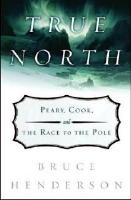
|
True
North: a real
Cook and Peary
emerge in a
new ‘race to
the pole’
account
Controversy
about the
1908/1909
discovery of
the North Pole
has raged for
95 years, and
generated
enough books
and articles
to fill a
fair-sized
library. Bruce
Henderson, the
latest author
to make a
literary
contribution,
differs in
several ways
from prior
writers on
this subject.
First of all,
he is a highly
acclaimed
researcher and
bestselling
author, with
additional
credentials as
a newspaper
reporter,
magazine
writer and
university
journalism
professor.
Secondly, he
is no stranger
to polar
research and
writing. His
2001 book, Fatal
North:
Adventure and
Survival
Aboard USS
Polaris, the
First U.S.
Expedition to
the North Pole,
is the best
and most
complete
account of the
last
expedition of
Charles
Francis Hall
to
northernmost
Greenland.
Last but
certainly not
least, he
enters the
controversy
without any
ties to either
Admiral Robert
E. Peary or
Dr. Frederick
A. Cook that
enables him to
render an
impartial
judgment on
the merits of
the rival
claimants.
> READ
THE FULL ACCOUNT
|
|
| Book
Review:
Exploring
Polar
Frontiers:
A
Historical
Encyclopedia
by
William
James
Mills
ABC-Clio
Inc.,
$149.98
ISBN
1576074226
900
p |
|
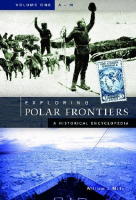
|
Exploring
Polar
Frontiers:
Mills’
long awaited
historical
encyclopedia
of the
Arctic
William
J. Mills had
been the
ultimate
resource
person for
anyone who
was probing
into the
depths of
Polar
exploration.
The
librarian at
the Scott
Polar
Research
Institute in
Cambridge,
he oversaw
what was
probably the
largest and
most
inclusive
collection
of printed
matter on
the subject.
> READ
THE FULL ACCOUNT
|
| Book
Review:
1421:
The Year
China
Discovered
America
by
Gavin
Menzies
NY:
Morrow,
2003,
385 pages,
many maps
&
illustrations
ISBN:
0060537639 |
|
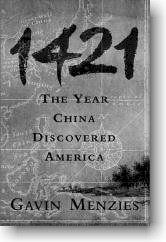
|
Were
Pre-Columbian
Chinese at Pole in
1421?
Author says that
Year China
Discovered America
After
years plowing
through the
underwaters of most
of the globe’s
seas, onetime Royal
Navy submarine
Commander Gavin
Menzies has charted
a new course, with
an environment ever
as murky as those in
the depths.
“Fascinating but
flawed” was the
Booklist review in
dissecting Menzies’
thesis that Chinese
fleets explored most
of the world decades
before Europeans
voyaged to the
Americas (according
to the author,
explorers such as
Columbus already
knew the Americas
were there because
they had access to
maps based on
Chinese records).
Menzies even argues
that Chinese
colonies were
planted in the
Americas,
disappearing from
view as they mingled
with indigenous
populations.
> READ
THE FULL ACCOUNT
|
A
dramatis
personae
in the high
Arctic, 1901
|
|
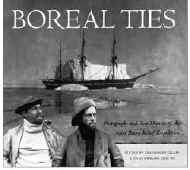
|
Boreal
Ties
Edited
by Kim Farley
Gillis and Silas
Hibbard Ayer III
(University
of New Mexico
Press)
The
1901 Erik Expedition
was significant in
many ways. It
represented the
last contact in
the field between
Frederuick A. Cook
and Robert E.
Peary. It was the
occasion of the
prophetic physical
examination and
diagnosis of Peary
by Cook.
And
it was a unique
insight into the
fascination that
Arctic exploration
was held by the
North American
public at the turn
of the century,
when Pole-seeking
was at its best-
and soon to become
its worst.
In
1899 Peary, on an
extended stay in
his Northern
Greenland
Expedition, had
suffered the loss
of seven toes to
frostbite at Fort
Conger but refused
to return to
receive proper
treatment (see
Ralph Myerson, MD:
“Peary’s Toes:
A unique medical
history of the
explorer’s loss
of his toes,”: Polar
Priorities,
2001, p 39-40).
When Josephine and
their seven
year-old daughter
went to Greenland
to persuade him to
come home, the die
was cast for the
Peary Relief
Expedition,
organized in 1901.
> READ
THE FULL ACCOUNT
| Book
Review:
The
Navigator of
New York
Cook
and Peary as
central
figures in a
new novel
by
Wayne Johnston
hb,
469 p. NY:
Doubleday
& Co.
ISBN
0385507674 |
|

|
Canadian
author Wayne
Johnson has
written a new
novel which has
part of its
setting in the
bustling streets
of late 19th
century New York
to the farthest
Arctic dominions
of his native
country. The
author of the
highly-acclaimed “The
Colony of
Unrequited
Dreams” has
now completed an
epic story of
“one man’s
quest for the
secret of his
origins” as a
theme that
includes Frederick
Albert Cook as the
central figure in
his novel.
As
a young child in
St. John’s,
Devlin Stead and
his mother,
Amelia, are
suddenly abandoned
by his father, Dr.
Francis Stead, who
flees north to
practice medicine
among the Eskimos.
Distraught by his
absence, Amelia
throws herself
into the icy ocean
from Signal Hill.
Rather than return
home, his father
joins the American
Lieutenant Peary
on one of his
attempts to reach
the North Pole,
but wanders off
from camp one
night and is never
seen again. Now
orphaned, Devlin
grows up an
outcast and a
loner, attended to
by his devoted
Aunt Daphne and
his taciturn
physician uncle.
> READ
THE FULL ACCOUNT
| Book
Review:
Polar
Reaches
The
History of
Polar
Exploration
by
Richard
Sale
220
p., many illus
& maps,
$29.95
ISBN:
0-89886-873-4
Seattle:
Mountaineers
Books
London:
HarperCollins
|
|
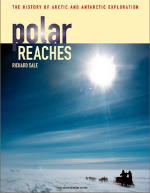
|
The
literal blizzard
of Polar books and
reprints in recent
years offers the
expected tapping
of a new interest
market in the
history and
personalities
which have made
the story of the
ends of our earth
so attractive to
readers. In
fact, the quirks
of publishing
bring the same
book in two
titles, equally
intriguing: To
the Ends of the
Earth in Great
Britain and its U
S counterpart, Polar
Reaches.
Author
Richard Sales is a
British
glaciologist who
by his own account
has "trekked
and traveled all
over the
world," with
an affinity for
the Arctic
regions. He
also is a mountain
climer of some
accomplishments,
having authored a
previuos book On
Top of the World,
a history of the
larger peaks.
Thus Sale is more
than the usual
"armchair"
observer, and his
comments may offer
greater currency
than others.
> READ
THE FULL ACCOUNT
|
The
Canadian 'Karluk'
expedition:
Bartlett was a hero,
Stefansson was not
|
|
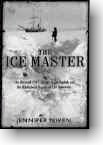
|
The
Ice Master: The
Doomed 1913 Voyage
of the Karluk
by
Jennifer Niven
(Hyperion,
$24.95)
Jennifer
Niven has combined
superlative
narrative skills
with meticulously
thorough research
to produce what is
certainly the most
complete and
accurate account
of the ill-fated
Karluk Expedition
of 191314. This
book is based on
the diaries,
journals,
unpublished and
published
manuscripts and
papers of the
members of the
expedition, and on
other pertinent
material as well
as public records
in governmental
archives.
Prominently
included in
Niven's research
is the diary of
and a personal
interview with
William Laird
McKinlay, the last
surviving member
of the expedition
and an individual
who devoted 60
years of his life
to a frank and
truthful
presentation of
the facts
concerning the
expedition.
> READ
THE FULL ACCOUNT
|
It's
not a chilling
story, it's a
blood-freezing
nightmare |
|

|
Ghosts
of Cape Sabine:
the Harrowing True
Story of the
Greely Expedition
by Leonard F.
Guttridge (Putnam,
$19.50)
reads like a
suspenseful novel,
with an exhaustive
mass of sources
used to
reconstruct the
story.
Alleged mutiny,
cannibalism, the
execution of one
soldier and the
loss of most of
the
expedition...makes
"harrowing"
an understatement.
Reviewed by Ted
Heckathorn.
>
READ
THE FULL ACCOUNT
|
| . |
|
|
The
Forgotten Man who
Filled
the Shoes of
Shackleton |
|

|
Frank
Wild: an
Explorer's
Biography
by Leif Mills (Caedmon
Whitby, $25.50)
is a long-awaited
biography of the
explorer always
known as the
"number two
man" in
Antarctic
exploration, being
understudy to the
giants of the
golden era--Scott,
Shackleton and
Mawson, yet
involved in more
expeditions
individually than
any of them.
The story of this
"ideal second
commander"
makes good
reading.
Reviewed by
Russell W.
Gibbons.
> READ
THE FULL ACCOUNT
|
| . |
|
|
The
Village Carpenter
who
Humbled the
Astronomer Royal |
|
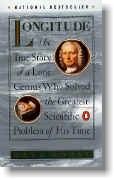
|
Longitude:
the True Story of
a Lone Genius who
Solved the
Greatest
Scientific Problem
of his Time
by Dava Sobel
(Penguin, $9.50)
is a great story
because it reminds
us that
institutional
ignorance and
bureaucratic
stupidity did not
end with Galileo
and in fact
continues today,
but the all-time
horror story for
scientific inquiry
was centered
around John
Harrison, a
self-educated
carpenter and
amateur clockmaker
of the early 18th
Century. The
subtitle tells it
all.
Reviewed by Jason
Lockwood.
> READ
THE FULL ACCOUNT
|
Cultural
Arrogance, Lies and
Cover-up by the
'Right People' |
|
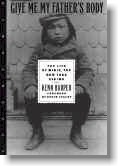
|
Give
Me My Father's
Body: The
Life of Minik, the
New York Eskimo
by Kenn Harper (Steerforth
Press, $24.00)
is a long deserved
small press
edition of a book
that was first
privately
published in 1990.
Kenn Harper has
done the research
on Minik and his
Greenland tribe,
so cruelly
exploited by
American explorers
and insulted in
the aftermath of
an institutional
museum community
that treated them
as but inventory.
It is also a story
of sheer greed and
theft.
Reviewed by Ralph
Myerson.
> READ
THE FULL ACCOUNT
|
Copyright
2007 - The Frederick A.
Cook Society
|